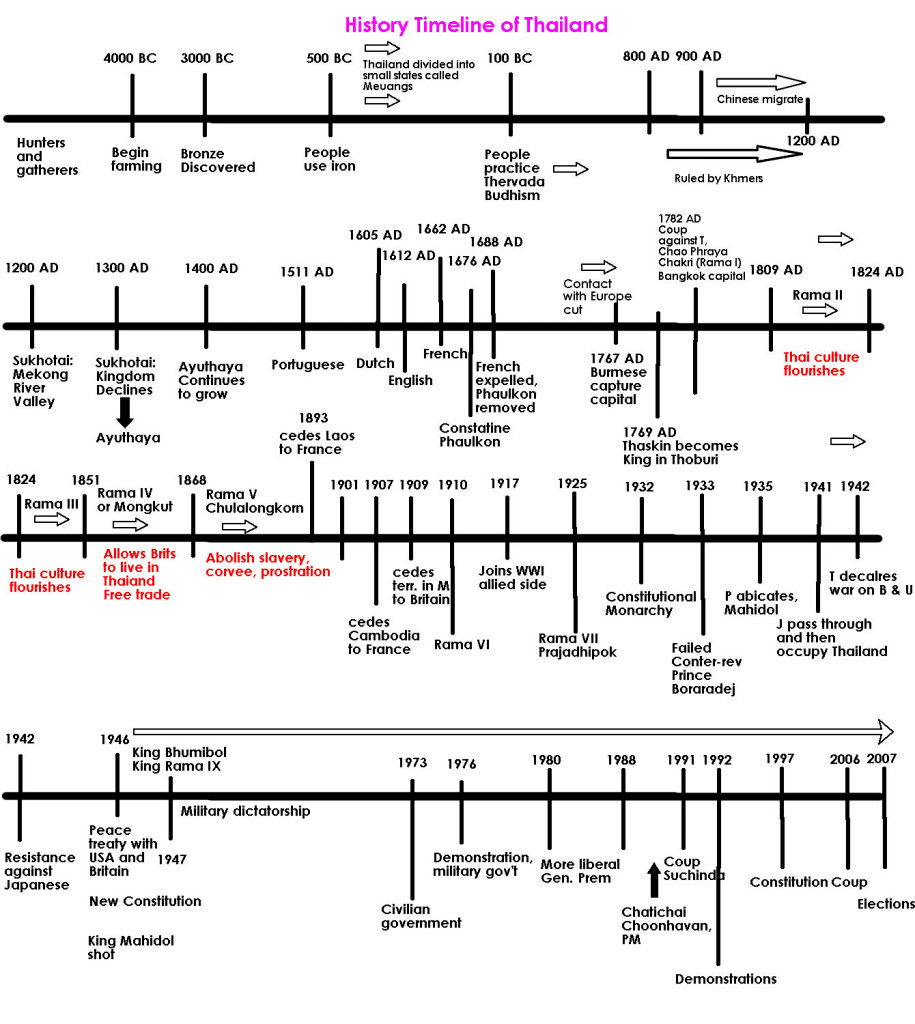/ayutthaya-thailand-things-to-do-58afffc83df78cdcd83f97b3.jpg)
Today, we will explore the history of Thailand. I hope we will have an understanding of:
- The important periods in history.
- Some important events and people in its history.
- A general idea of the current political situation of Thailand.
It is impossible to have a deep understanding of the Thailand history in just one class period; one semester is probably not enough! However, we hope that this will give you some background information which will be useful when you visit Thailand!
Brief Historical Timeline and Discussion
First, let’s read the timeline and discuss the history of Thailand. The timeline is based on this article.
Overview of the History of Thailand
Early History: The earliest evidence of human habitation in the region now known as Thailand dates back to prehistoric times, with archaeological finds indicating that the area was home to various ancient civilizations.
Dvaravati Period (6th - 11th century): The Mon people established the Dvaravati culture, characterized by the spread of Theravada Buddhism and the construction of significant religious monuments.
Khmer Influence (9th - 13th century): During this period, the Khmer Empire extended its influence into the region, particularly in the northeast. Many temples were built during this time, reflecting Khmer architectural styles.
Sukhothai Kingdom (1238 - 1438): Often considered the first Thai kingdom, Sukhothai was established after a revolt against the Khmer Empire. It marked the beginning of Thai culture, language, and the Thai script.
Ayutthaya Kingdom (1350 - 1767): This kingdom succeeded Sukhothai and became a major center of trade, culture, and military power. It established diplomatic relations with many foreign countries, including China, Japan, and European nations. Ayutthaya's influence extended over much of the region, but the kingdom fell to Burmese forces in 1767.
Thonburi Period (1767 - 1782): After the fall of Ayutthaya, General Taksin established the Thonburi Kingdom and briefly reunified the territories. However, his reign ended with his deposition in 1782.
Rattanakosin Period (1782 - present): King Rama I founded the Chakri Dynasty and moved the capital to Bangkok. The Rattanakosin Kingdom marked a period of modernization and centralization. The dynasty continues to rule to this day, with the country evolving into a constitutional monarchy in the 20th century.
19th - 20th Century: Thailand was never colonized by European powers, largely due to skillful diplomacy by the monarchy. However, it did make significant concessions to avoid colonization. In the 20th century, Thailand modernized rapidly, going through periods of absolute monarchy, military rule, and eventually, a move towards democracy.
A history of Thailand created by James

Second, let’s answer some follow-up questions to get a slightly deeper understanding.
Follow-up Questions on Thai History
- Describe the Tai ethnic group. Who are they and what is their significance in Thai history? (Introduction, Early Tai Culture)
- Explain the differences between the Mon, Khmer, and Tai groups. (Mon-Khmer civilizations)
- What is Therevada Buddhism and why is it important? (Mon-Khmer civilizations, Sukhotai and Lan Na)
- What other Tai Kingdoms were there during the Sukhothai period? (Sukhotai and Lan Na)
- How did the Ayutthaya Kingdom end? (The Ayutthaya Period)
- Describe King Mongkut (Rama IV) (Mongkut and the opening of Siam to the West)
- Describe King Chulalongkorn (Rama V) (Chulalongkorn and the foundations of modern Thailand)
- When did Thailand become a constitutional monarchy? (The 1932 Coup and the creation of a constitutional order)
- What was Thailand's relationship with Japan and the other allies during World War II? (The Phibsunbonsongkhram dictatorship and World War II)
- Who is Thaksin Shinawatra? (Attempts to institute populist democracy)
Answer the questions here:
